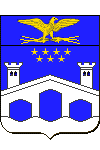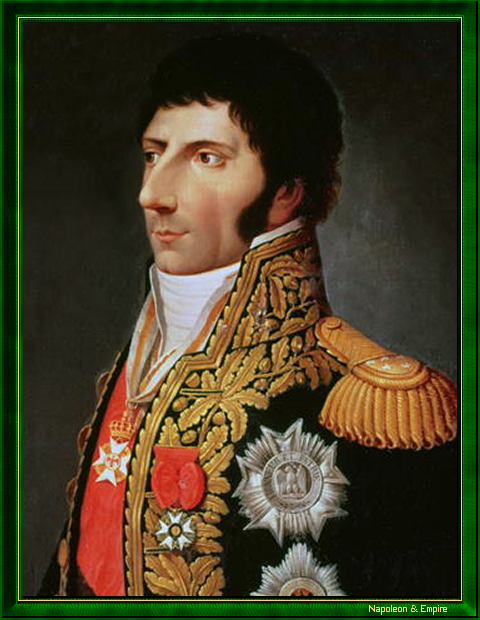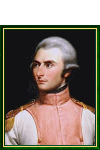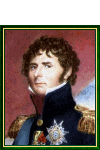Prince of Pontecorvo
Pronunciation:

Jean-Baptiste Jules Bernadotte was born on January 26, 1763 in Pau in the region of Béarn. His father was the local prosecutor who hoped his son would also become a lawyer, but Bernadotte embraced a career in the army in 1780.
Nicknamed Belle-Jambe, he was still a non-commissioned officer in 1790 but by June 1794 he was a brigadier general and then promoted to général de division (major general) in October of that year. After serving in the Rhine Army, he served under Napoleon Bonaparte in the Italian Army in 1797. Bonaparte welcomed him with open arms and in August tasked him with presenting the Directory with the regimental flags captured from the enemy. The letter accompanying the flags praised Bernadotte considerably. This was on the eave of the coup d'état of 18 Fructidor, Year V (September 4, 1797). While Charles Augereau who had left a few days earlier was tasked with carrying out the coup, Bernadotte's job was to ensure constant communication between him and Bonaparte.
The contacts he made during these events allowed him the leave what he considered to be a junior role in the Italian Army. He was given the opportunity to display his talents as the ambassador to Vienna from February to April 1798. His mission was cut short when his tactlessness gave the Austrian government the opportunity to organized a popular protest against the French Embassy. As a result, he had to content himself with the command of the observation army in the Lower Rhine. However, his forces were soon regrouped into a larger contingent and Bernadotte found himself answering to General André Masséna.
When he was forced to resign his command following a serious failure, Bernadotte imputed the charges to the government. Surprisingly, he was cleared of wrongdoing and was named Minister of War. He held this portfolio from July to September 1799 and used his influence to try to end the Egyptian Expedition. He was ultimately prevented by Paul Barras and Charles-Maurice de Talleyrand-Périgord. As a result, Bernadotte was assumed to be a Jacobin and the new Director, Emmanuel Siéyès, was eager to see him resign though Bernadotte had no intention of doing so. The Abbé was suspicious that General Bernadotte would attempt a coup d'état for the neo-Jacobins before the Abbé could make his own power play.
Despite maintaining a considered neutrality during the coup d'état of 18 Brumaire (November 9, 1799), Bernadotte remained on very good terms with the First Consul Napoleon Bonaparte. He even married Bonaparte's ex-fiancé, Désirée Clary, on August 17, 1798. Clary was also the sister of Joseph Bonaparte's wife. Their first and only son, Oscar, was born the next year. In the new regime, Bernadotte was made a Councillor of State and was put in command of the Western Army.
In this role, he was implicated in the Butter Jar conspiracy which was orchestrated by his chief of staff, General Simon. Bernadotte was stripped of command once again in 1802. His next posting was to be as ambassador to the United States, but his was unable to make the journey across the Atlantic when the Peace of Amiens was broken. Napoleon made him a Marshal in 1804 and the Prince of Pontecorvo in 1806.
The next few years passed uneventfully for Bernadotte. His participation in military operations was at best mediocre and at worst inadequate. While he was at the Battle of Austerlitz, he did nothing to distinguish himself and left Louis-Nicolas Davout to tackle the main force of the Prussian army at Auerstaedt for which he was almost court-martialled. His inertia compromises the operation of Pultusk. He was late arriving at Preussisch-Eylau and the Saxons he commanded at Wagram broke ranks during the battle. Napoleon's patience finally ran out when he heard of this latest episode and he stripped Bernadotte of his command. This would be his last military posting under the Empire apart from commanding the Army of the Escaut from August to September 1809.
In 1810, as he was about to travel to Rome to take up the role of Governor General, he learned that he had been elected Crown Prince of Sweden and heir to King Charles XIII by the Estates-General of Örebro on August 21. The Swedish King was childless and the only other option was the King of Denmark. As Bernadotte was one of the most loyal allies of the French Emperor, the Swedes hoped to escape Napoleon's wrath by choosing one of his marshals. Napoleon, surprised though displeased, authorized Bernadotte to take the Swedish crown hoping to profit from the situation in the meantime. He was unable to do so.
In 1813, when the Emperor's power began to falter, Bernadotte joined the coalition formed against France with 30 000 soldiers. He was given control of all military operations which made him effectively commander-in-chief for the allies. Unfortunately for France, he began to display a new talent for military strategy inspired by Napoleon's tactics. He defeated Nicolas Oudinot at Gross Beezen on August 23 and did the same to Michel Ney at Dennewitz on September 6. He also played an important role in the Battle of Leipzig (a.k.a. Battle of the Nations).
The next year, he refrained from entering France with the allies in order to give himself the chance to succeeded the Emperor on the French throne which was an aspiration he admitted to one of the Tsar's aides-de-camp. It seems that Alexandre I supported this move as it would allow one of his nephews to become King of Norway. As for Madame de Staël, she supported the plan whole-heartedly. But Talleyrand had other ideas. For his efforts, Bernadotte was made King of Norway.
In 1818, he became King of Sweden and Norway as Charles XIV John and reigned for a peaceful 26 years. He died of apoplexy on March 8, 1844 in the royal palace in Stockholm and is buried in the Riddarholm Church in the Swedish capital.
"Marshal Bernadotte" painted 1805 by Johann Jacob de Lose (1755-1813).

During his reign, Charles XIV John allegedly would not allow his doctors to examine his naked torso. The explanation was discovered as his body was prepared for the funeral: the former Republican solder had a tattoo on his chest (some sources report it was the left arm) and among other Jacobin symbols with the words, Death to Kings!
The named Bernadotte can be found on the 3rd column (north side) of the Arc de Triomphe and two equestrian statues in bronze of the monarch he became are located in Stockholm and Oslo.
Freemasonry: Marshal Bernadotte may have been initiated in France between 1785 and 1786 at the "Affectionate Fraternity" Lodge or at a military one. He became a Grand Master in Swedish freemasonry in 1811, one year after he was elected Crown Prince.
In 1999, the Postal Service of Sweden released a lower charge stamp bearing the image of Charles XIV John.
Other portraits

Enlarge
"Jean-Baptiste Bernadotte in 1792", painted 1834 by Louis-Félix Amiel (Castelnaudary 1802 - Joinville le Pont 1864).

Enlarge
"Marshal Bernadotte, Prince of Ponte-Corvo" by François Pascal Simon Gérard, ca. 1811.